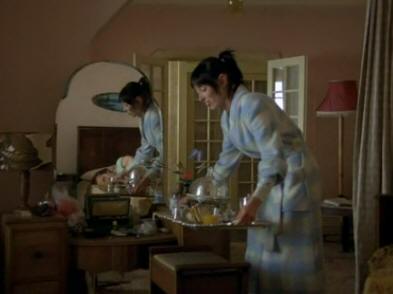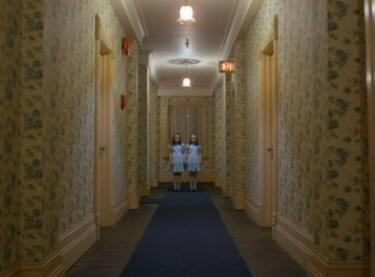CHAPTER SEVEN A unique device that Kubrick used to encode hidden narratives in his films is what I call Unannounced Dream Sequences. The concept is simple. In the surface narrative the scene in question is offered as a literal event in the story structure – something that really happens to the characters, but in the hidden narrative the scene is entirely in the characters imagination – a dream sequence. Rather than overtly show us that the character is asleep, Kubrick uses subliminal indicators which, if identified by the viewer, reveal the symbolic dream nature of the scene. Typically Kubrick would use these dream sequences to encode a different insight into other events that the character experienced in their waking state earlier in the film. Here are some specific examples of unannounced dream sequences in Kubrick’s work.
In The Shining dream sequences are again used as part of a hidden narrative. Just as Kubrick was not a believer in the supernatural or the after-life, he never presented as a person who believed in the phenomena of psychic abilities either. The subliminal details of little Danny’s shining visions reveal that his psychic episodes are simply nightmares about his father’s psychotic tendencies. This is a fairly complex aspect of the film, which will be explored over several chapters of this analysis, but for now we’ll simply explore the encoded details that reveal which scenes are dream sequences. By far the biggest giveaway is Danny’s description of his own psychic episodes. Halloran asks Danny how his imaginary friend Tony tells him things and Danny replies, “It’s like I go to sleep and he shows me things, but when I wake up I can’t remember everything.” Remember also that Danny’s very first psychic episode in the film resulted in him being found unconscious “I remember mommy saying ‘wake up Danny, wake up’.” Much later in the film Danny is heard in his bedroom shouting “Redrum.” His mother enters the room and shakes him. The ensuing dialogue again hints at the nightmare nature of his visions. Wendy: “Wake up Danny, you were having a bad dream.” Danny: “Danny can’t wake up Mrs Torrance. Danny’s gone away Mrs Torrance.” One aspect of the film that puzzled me for many years, and which makes perfect sense when considered in the context of dreams, is the bizarre carpets in the hallways around room 237. These carpet patterns demand our attention and have been commented upon time and time again by reviewers as having an unsettling effect upon the viewer.
In chapter three I suggested that these carpets and the ones in room 237 are part of the fairy tale and cartoon themes of the story. Well, they also fit neatly into the dream logic of Danny’s visions. Notice that the cartoon-like carpet designs are drastically different to the Indian art seen elsewhere in the hotel. It’s as if the playschool aesthetics of childhood have manifested themselves in the hotel decor. The room 237 hallways don’t exist. They are a product of Danny’s dreamscape interpretation of the Overlook. Think of it this way. Danny seems to be the only character who ever explores the cartoon-like parts of the hotel. The only exception to this is when Jack enters room 237 and then stumbles back out into the hallway after encountering the ugly woman. There is an explanation for this also, but we’ll explore that in the next chapter. Some other details hinting at the discrepancies of décor are that in the first Colorado Lounge scene where Jack and Wendy are being shown around, a man walks down the main stairway of the room carrying a rolled up carpet or rug. Its design looks nothing like the crazy carpet designs of Danny’s dream sequences. That may seem a bit vague, but if you remember that when shooting a scene like this one every prop and every action, even by non-speaking extras, is thoroughly arranged in advance. Kubrick will have instructed his crew to have this guy carry a carpet down the stairs.
The one scene in the film where we almost get to see a continuous transition between the Colorado Lounge and the upper floors (where room 237supposedly is) occurs when Wendy and Jack fight on the stairs. Wendy backs up to the top of the steps, almost enough for us to see the real designs of the upstairs carpets, but then whacks Jack over the head and the scene ends.
There is one other shot of Jack typing, in which we view him from the upstairs level, but even here there is no view of the upstairs carpets.
Another important indicator of Danny’s dream sequences is their timing in relation to other scenes. The very first tricycle sequence, where Danny rides around the Colorado Lounge, is followed by Wendy bringing Jack breakfast in bed. We see Jack asleep through the mirror and the mirror overlaps the doorway to Danny’s room, possibly a hint that Danny is also asleep. This of course would confirm the tricycle sequence as one of Danny’s dreams.
Just before the second tricycle sequence, the one in which Danny tries to enter the locked doors of room 237, the hotel exterior is shown in the late evening, followed by a shot of Wendy preparing dinner for the family. This cuts to the tricycle sequence and then to Jack typing in the Colorado Lounge at night - the one where Wendy disturbs Jack's writing and he tells her where to go. A logical mismatch here is that Jack doesn’t want to be disturbed, yet Danny’s tricycle was shown riding around the upper floor of the Colorado Lounge. If Jack couldn’t tolerate his wife walking in and disturbing him then why would he tolerate the noise of Danny’s tricycle coming from upstairs? Combined with the lateness of the hour this suggests that Danny was again dreaming the tricycle sequence. And now onto the third and final tricycle sequence – Danny’s encounter with the twin girls. There’s a lot going on in the scene, but for now I’ll just highlight the indicators of it being a dream. From the window behind the two girls we can see that the sequence is set at night when Danny would least likely be riding around on his tricycle. But what’s also interesting is the wallpaper. As mentioned earlier this wallpaper appears in just two places in the hotel – the dead girls sequence and in the far background outside the Torrance apartment entrance. In the dead girls’ scene if we ignore the scary apparition and just look at the wallpaper, it’s quickly apparent that the flower patterns form an endless series of question marks.
It seems that Kubrick wants us to question something here – be it the décor, the identity of the girls, the location, or even whether the scene is real. If this is a dream sequence then the question arises as to why Danny would have such a dream. We’ll return to this mystery later. After seeing the dead girls Danny talks to himself through his finger, “Remember what Mr Halloran said. It’s just like pictures in a book Danny. It isn’t real.” This is strange because we witnessed a long dialogue sequence between Danny and Halloran, but those words were not spoken. We can only assume that their conversation continued from where the scene was cut, or that Halloran never even spoke those words at all. This is another mystery that we’ll return to in later chapters. Moving on from the tricycle scenes, the next dream sequence is when Danny enters room 237. Again we have these odd carpets and this time a tennis ball is rolled toward Danny with inhuman precision.
Now some of you may be thinking, “Hold on a minute, room 237 was a real event. Danny had the injuries on his neck to prove it.” In the hidden narrative though, the room 237 scenes are also dream sequences, because Danny’s injuries came from a very different experience, which will be explored in the next chapter. Immediately after Danny enters room 237 we fade to a scene in which Jack has his nightmare about killing the family with an axe. Again the concept of dreams is present in the narrative. When Halloran and Danny have their shared shining episode, in which we see inside room 237, both of them happen to be laying in bed. Halloran looks like he’s about to nod off to sleep and then his psychic vision begins. Danny looks utterly traumatized as he shakes in his bed, but his eyes are open. So this time it seems he is at least partially awake. Confused? Let’s move on …
|







